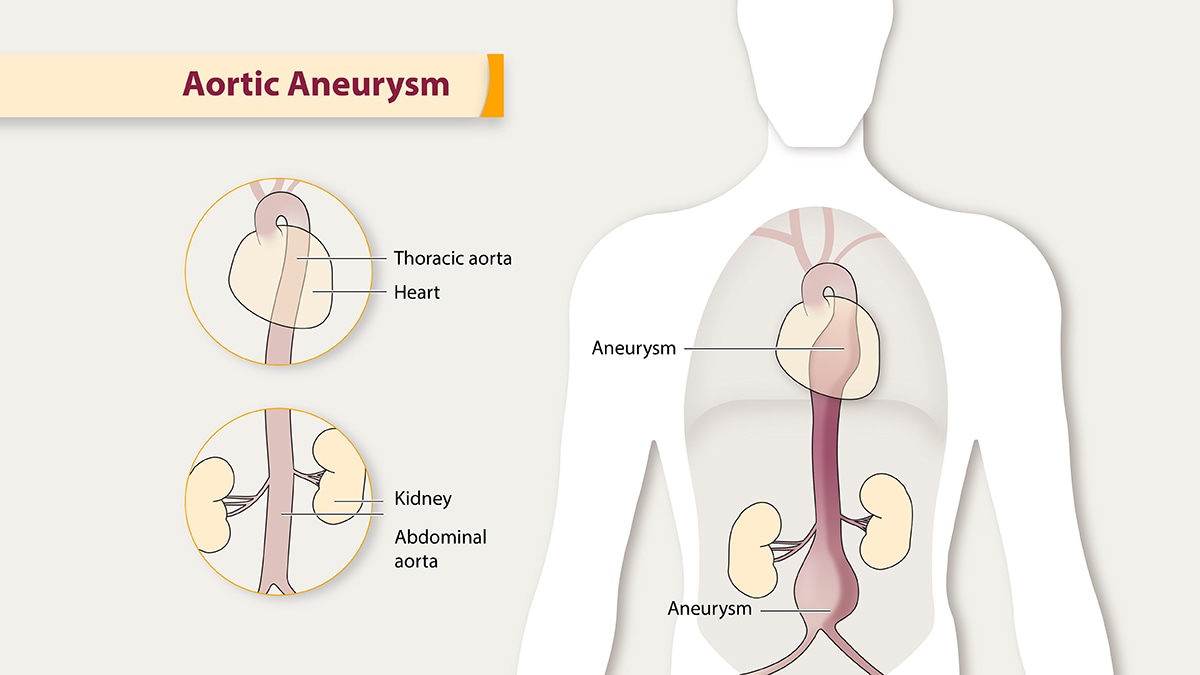Key points
- An aortic aneurysm is a dangerous balloon-like bulge in the aorta, the large artery that carries blood from the heart through the chest and torso.
What it is
Aortic aneurysms can dissect or rupture:
- The force of blood pumping can split the layers of the artery wall, allowing blood to leak in between them. This process is called a dissection.
- The aneurysm can burst completely, causing bleeding inside the body. This is called a rupture.
- Dissections and ruptures are the cause of most deaths from aortic aneurysms.

Facts about aortic aneurysm in the United States
- Aortic aneurysms or aortic dissections were the cause of 9,904 deaths in 2019.1
- In 2019, about 59% of deaths due to aortic aneurysm or aortic dissection happen among men.1
- A history of smoking accounts for about 75% of all abdominal aortic aneurysms.2
- The US Preventive Services Task Force recommends that men aged 65 to 75 years old who have ever smoked should get an ultrasound screening for abdominal aortic aneurysms, even if they have no symptoms.3
Types
Thoracic aortic aneurysm
A thoracic aortic aneurysm happens in the chest. Men and women are equally likely to get thoracic aortic aneurysms, which become more common with increasing age.4
Thoracic aortic aneurysms are usually caused by high blood pressure or sudden injury. Sometimes people with inherited connective tissue disorders, such as Marfan syndrome and Ehlers-Danlos syndrome, get thoracic aortic aneurysms.
Signs and symptoms of thoracic aortic aneurysm can include the following:
- Sharp, sudden pain in the chest or upper back.
- Shortness of breath.
- Trouble breathing or swallowing.
Abdominal aortic aneurysm
An abdominal aortic aneurysm happens below the chest. Abdominal aortic aneurysms happen more often than thoracic aortic aneurysms.
Abdominal aortic aneurysms are more common in men and among people age 65 and older. Abdominal aortic aneurysms are more common among White people than among Black people.5
Abdominal aortic aneurysms are usually caused by atherosclerosis (hardened arteries), but infection or injury can also cause them.6
Abdominal aortic aneurysms often don't have any symptoms. If an individual does have symptoms, they can include the following:
- Throbbing or deep pain in the back or side.
- Pain in the buttocks, groin, or legs.
Other types
Aneurysms can happen in other parts of your body. A ruptured aneurysm in the brain can cause a stroke. Peripheral aneurysms—those found in arteries other than the aorta—can happen in the neck, in the groin, or behind the knees. These aneurysms are less likely to rupture or dissect than aortic aneurysms, but they can form blood clots. These clots can break away and block blood flow through the artery.
Risk factors
Diseases and unhealthy behaviors that damage your heart and blood vessels also increase your risk for aortic aneurysm. Smoking is the most important behavior related to aortic aneurysm.
Other factors include
Some inherited connective tissue disorders, such as Marfan syndrome and Ehlers-Danlos syndrome, can also increase your risk for aortic aneurysm. Your family may also have a history of aortic aneurysms that can increase your risk.
- National Center for Health Statistics. About Multiple Cause of Death, 1999–2019. Accessed February 1, 2021. https://wonder.cdc.gov/mcd-icd10.html
- Norman PE, Curci JA. Understanding the effects of tobacco smoke on the pathogenesis of aortic aneurysm. Arterioscler Thromb Vasc Biol. 2013;33(7):1473–1477.
- US Preventive Services Task Force. US Preventive Services Task Force; 2014. Accessed February 16, 2018.
- Clouse WD, Hallett JW Jr., Schaff HV, Gayari MM, Ilstrup DM, Melton 3rd LJ. Improved prognosis of thoracic aortic aneurysms: a population-based study. JAMA. 1998;280(22):1926–1929.
- Guirguis-Blake J, Wolff TA. Screening for abdominal aortic aneurism. Am Fam Physician. 2005;71(11):2154–2155.
- Creager MA, Loscalzo J. Diseases of the aorta. In: Fauci AS, Longo DL, Kasper D, et al., eds. Harrison's Principles of Internal Medicine. 17th ed. McGraw-Hill; 2008:1563–1567.
